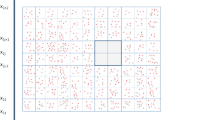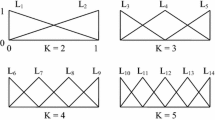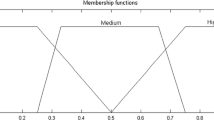Abstract
In many modern data analysis scenarios the first and most urgent task consists of reducing the redundancy in high dimensional input spaces. A method is presented that quantifies the discriminative power of the input features in a fuzzy model. A possibilistic information measure of the model is defined on the basis of the available fuzzy rules and the resulting possibilistic information gain, associated with the use of a given input dimension, characterizes the input feature’s discriminative power. Due to the low computational expenses derived from the use of a fuzzy model, the proposed possibilistic information gain generates a simple and efficient algorithm for the reduction of the input dimensionality, even for high dimensional cases. As real-world example, the most informative electrocardiographic measures are detected for an arrhythmia classification problem.
Access this chapter
Tax calculation will be finalised at checkout
Purchases are for personal use only
Preview
Unable to display preview. Download preview PDF.
Similar content being viewed by others
References
V. Cherkassky and F. Mulier, “Learning from data”, John Wiley and Sons Inc., 1998.
C. Apte, S. J. Hong, J. R. M. Hosking, J. Lepre, E. P. D. Pednault, and B. K. Rosen, “Decomposition of heterogeneous Classification problems”, Intelligent Data Analysis, Vol. 2, n. 2, 1998.
L. A. Zadeh, “A fuzzy-algorithmic approach to the definition of complex or imprecise concepts”, Int. J. Man-Machine Studies, 8: 249–291, 1976.
A. De Luca, and S. Termini, “A definition of nonprobabilistic entropy in the setting of fuzzy sets theory”.
C. Z. Janikow, “Fuzzy Decision Trees: Issues and Methods”, IEEE Trans. Syst. Man and Cyb. PartB: Cybernetics, 28: 1–14, 1998.
M. R. Berthold, K. P. Huber, “Comparing Fuzzy Graphs”, Proc. of Fuzzy-Neuro Systems, pp. 234–240, 1998.
M. R. Berthold, J. Diamond, “Constructive Training of Probabilistic Neural Networks”, Neurocomputing 19: 167–183, 1998.
R. A. Fisher, “The use of multiple measurements in taxonomic problems”, Annual Eugenics, II, John Wiley, NY. 7:179–188, 1950.
C. Blake, E. Keogh, and C. J. Merz. UCI Repository of machine learning databases [http://www.ics.uci.edu/~mlearn/MLRepository.html]. Irvine, CA: University of California, Department of Information and Computer Science, 1998.
W. Zong, D. Jiang. “Automated ECG rhythm analysis using fuzzy reasoning”, Proc. of Computers in Cardiology, pp. 69–72, 1998.
Author information
Authors and Affiliations
Editor information
Editors and Affiliations
Rights and permissions
Copyright information
© 1999 Springer-Verlag Berlin Heidelberg
About this paper
Cite this paper
Silipo, R., Berthold, M.R. (1999). Discriminative Power of Input Features in a Fuzzy Model. In: Hand, D.J., Kok, J.N., Berthold, M.R. (eds) Advances in Intelligent Data Analysis. IDA 1999. Lecture Notes in Computer Science, vol 1642. Springer, Berlin, Heidelberg. https://doi.org/10.1007/3-540-48412-4_8
Download citation
DOI: https://doi.org/10.1007/3-540-48412-4_8
Published:
Publisher Name: Springer, Berlin, Heidelberg
Print ISBN: 978-3-540-66332-4
Online ISBN: 978-3-540-48412-7
eBook Packages: Springer Book Archive




